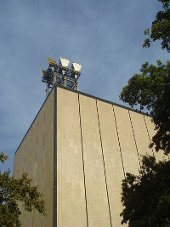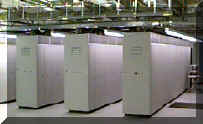What is a Central Office

Metropolitan central office building housing multiple telephone exchanges with a microwave tower on top. Note the lack of windows which is common for central office buildings.
Central office, telephone exchange, switching exchange and central office telephone switch are terms often used interchangeably in America to describe the same thing. Technically, a central office is a building housing equipment used to connect and route telephone calls in the public switched telephone network (PSTN).
A telephone switching exchange, or "switch" for short is the main piece of equipment located within the central office building. Multiple telephone switches each capable of handling hundreds of thousands of calls per hour may be housed within a central office.
In common use, a telephone switching exchange, or telephone switch intended for use inside a central office building is most frequently called a central office switch, central office or CO for short. When a central office refers to a building versus telephone switching hardware depends largely on the context in which it's used.
Telephone Exchange
The concept of a telephone exchange, (central office) dates to at least the age of telegraphy when electrical switches were used to connect multiple telegraph lines. Manually interconnected voice tube communication may even pre-date telegraph switching.
In the early years, a human operator sat, or stood before a switchboard and manually connected call circuits. Over time, human operators were increasingly replaced by electro-mechanical switches which were in turn replaced by electronic switches.
Digital Central Office Switch
In the US, digital CO switches have all but replaced older technology switches except in remote areas and as relics from the Cold War where requirements exist for switching equipment capable of surviving a nuclear EMP.
Unlike prior CO switch technologies that connected circuits thereby permitting audio communication to pass through them as analog electrical waveforms, digital switches sample the analog waveform, perform an analog to digital conversion on the sample and send the resulting digits to a destination switch where the digits are converted back into an analog waveform by a process of digial to analog conversion.
In the case of digital telephone terminals, the conversion from analog to digital is performed within the telephone itself.
VoIP and Central Office Switching
The most recent advancement in digital central office switching technology involves a move away from circuit switched TDMA technology and towards the use of voice over internet protocol as the underlying carrier protocol and transport mechanism.

Multiple one hundred thousand line Nortel DMS100 central office switches installed inside a central office building.
In traditional circuit switching, one continuous electrical circuit was maintained between two telephones for the duration of the call. With VoIP, the digitized voice signals are placed in numbered IP packets which travel independently via many different routes to their destination. Packets arriving out of sequence are not a problem because the far end equipment reassembles the packets in proper sequence and in the case of voice calls, performs a digital to analog conversion of the digitized information back into audio waveforms -- all within a fraction of a second.




